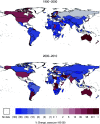Perplexities of pertussis: recent global epidemiological trends and their potential causes
- PMID: 23324361
- PMCID: PMC9151176
- DOI: 10.1017/S0950268812003093
Perplexities of pertussis: recent global epidemiological trends and their potential causes
Abstract
Recent much-publicized increases in pertussis case reports in some countries with high vaccine coverage have raised concerns about its current and future control. The ubiquity of this trend, however, remains unexamined. In an attempt to paint a global picture, we used case counts to determine which countries experienced statistically significant trends in incidence over the past two decades and to map changes in incidence during this period. These data reveal that pertussis resurgence is not a universal phenomenon. The heterogeneity in incidence trends, even in countries with superficially similar demography, socioeconomic conditions and vaccination programmes, is striking and requires explanation. In this opinion piece, we review and assess the multifaceted proposed explanations incorporating evolution, population dynamics, and the details of immunization programmes. While we do not solve the riddle that is pertussis epidemiology, we highlight critical aspects that are likely to hold the key to understanding its worldwide epidemiology.
Figures



References
-
- Cherry JD. Pertussis in the preantibiotic and prevaccine era, with emphasis on adult pertussis. Clinical Infectious Diseases 1999; 28 (Suppl. 2): S107–111. - PubMed
-
- Crowcroft NS, et al. How best to estimate the global burden of pertussis? Lancet Infectious Diseases 2003; 3: 413–418. - PubMed
-
- Rohani P, Drake JM. The decline and resurgence of pertussis in the US. Epidemics 2011; 3: 183–188. - PubMed
Publication types
MeSH terms
Substances
Grants and funding
LinkOut - more resources
Full Text Sources
Other Literature Sources
Medical
Miscellaneous

